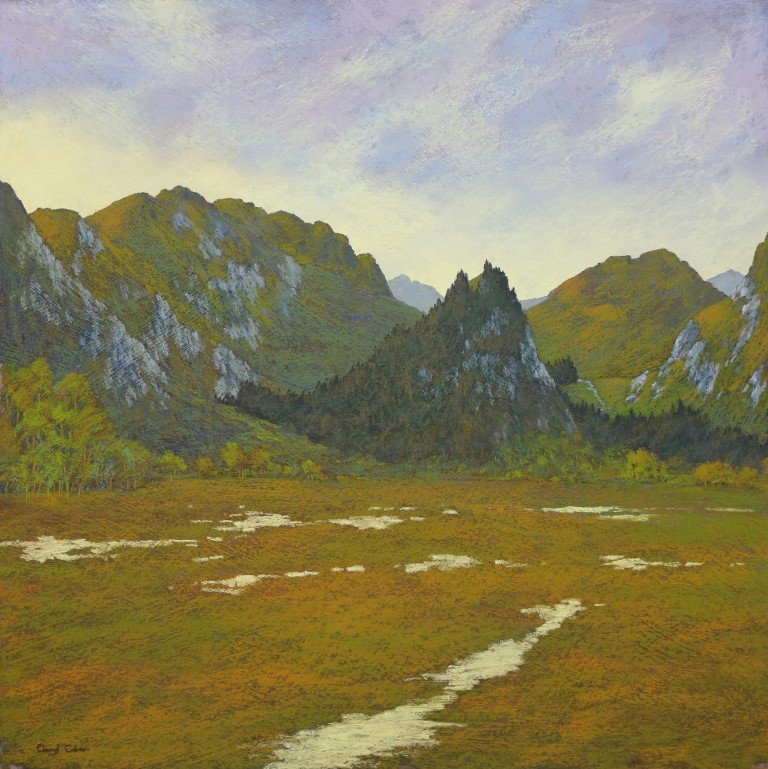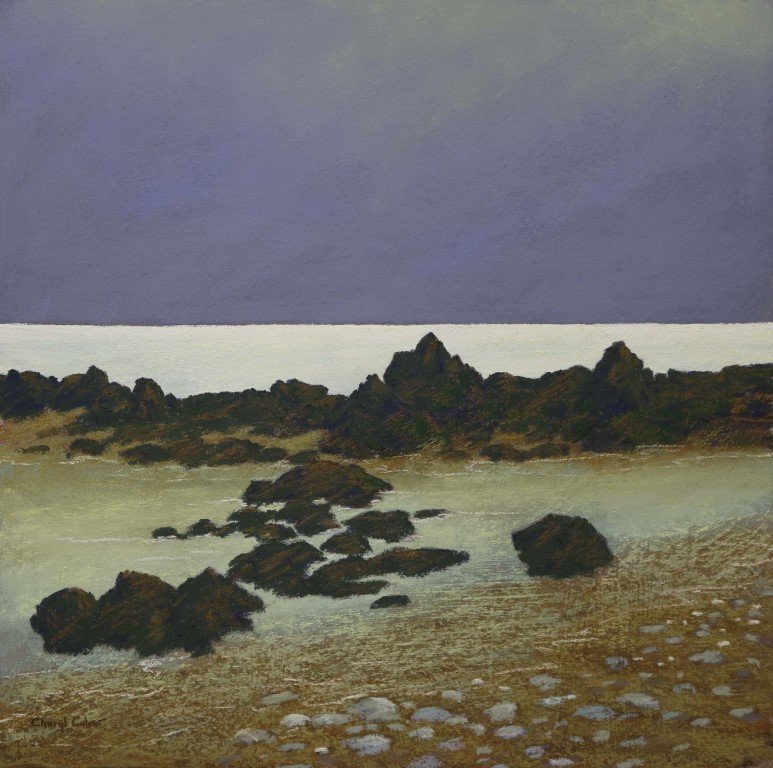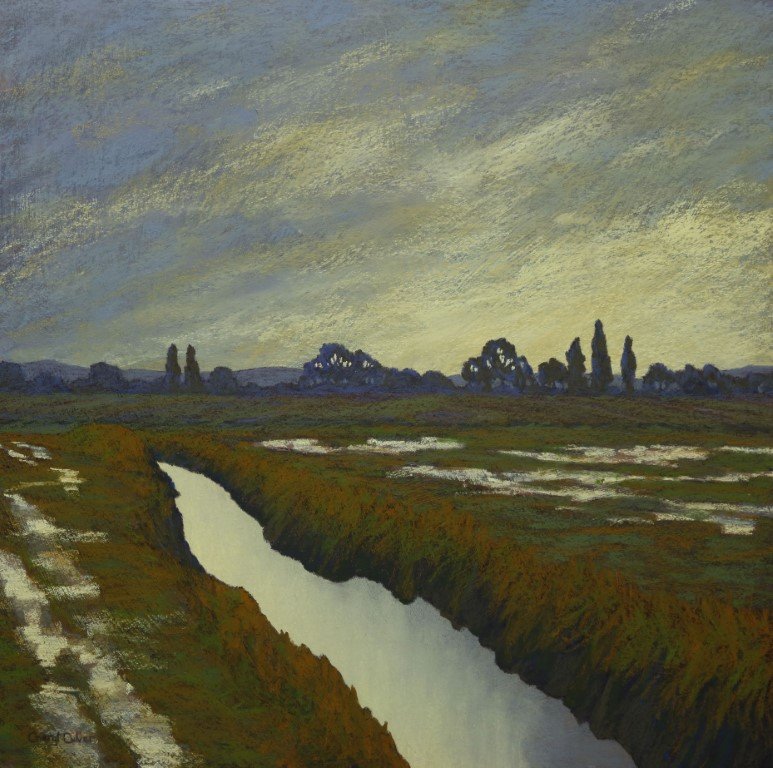ARTIST INTERVIEW: Cheryl Culver
Tell me about yourself and your journey to becoming an artist. What inspired you?
From a small child I was always drawing. I was a shy child and drawing gave me confidence. I think I must have been about seven when I won a visit to the circus to meet Coco the Clown, after colouring in a small image in the Bristol Evening Post. A few years later, I won a signed Adrian Hill book from Sketch Club on the BBC and then I won a signed Wobble Board from Rolf Harris!! (This may be valuable one day!!). Again, from a BBC programme. There now I have given away my age.
Although my family had no art contacts, mum and dad supported me totally.
I suppose my initial inspiration came from my art teacher; Mr Jacques, at Thornbury Grammar School.
You have always been an artist, whether that be working as an interior designer or running a business with your sister, Val Gould, creating a range of pieces including etched brass bowls; one of which can now be found in the Victoria & Albert Museum in their permanent collection. How did you come to be a landscape artist? Would you say you are quite an experimental individual?
I am truly happiest walking my dog in the early morning away from people and surrounded by the landscape. I can’t get excited by Still Life, or man-made structures or painting portraits, although I have painted a few over the years. I do get excited by the sky and its changing moods, reflective water surfaces, rocks and wilderness. Hence the landscape artist came to be.
I don’t think I am experimental. I try to capture an atmosphere, a mood, a ‘Sense of Place’ and try to make the medium do that.
Why are you drawn to the countryside? How do you portray your experience in the countryside through your work?
I grew up in the Severn Valley in a limestone cottage, surrounded by Beech woods and fields, red squirrels and a silence one could hear. I think I am always looking for that, even now and it is increasingly hard to find.
I have been told that my paintings make good bereavement cards??? Maybe it is peace tinged with sadness at the loss of tranquillity in this country. My landscapes are empty and in a sense timeless, maybe that is what I am searching for?
How does your medium help you to achieve the look and feel you’re trying to convey?
Pastel is an incredible medium; it has such a high pigment content. The colours sing, they have depth and luminosity. The paintings change with the time of day, it’s almost like watching the sun go down as the light changes. The textured primer I use, Golden Acrylic Pastel Primer, helps to make the landscape work, it is ideal for rough hillsides and fields. To me it achieves the ‘the look and feel’ of what I am trying to say.
How does your medium help you to achieve the look and feel you’re trying to convey?
Pastel is an incredible medium, it has such a high pigment content. The colours sing, they have depth and luminosity. The paintings change with the time of day, it’s almost like watching the sun go down as the light changes. The textured primer I use, Golden acrylic Pastel Primer helps to make the landscape work, it is ideal for rough hillsides and fields. To me it achieves the ‘the look and feel’ of what I am trying to say.
Are there any artists in particular who you admire? Do they have an influence on your own work?
Now for the sticky question. I always have difficulty answering this one. I don’t think I have one and my influences are based on my own wanderings. To be honest, I live in my own world and although I love the work of for example; David Curtis and Katrina Wallis-King, it is their ability to capture the feel of the landscape/seascape that I love, but beyond that they do not influence me, I plough my own farrow.
What is your process for creating one of your works? How does creating art make you feel?
The starting point is a sketch book with marker pen or pencil, my dog and a walk. I always work from these drawings not photographs. It’s like a first editing of the scene. The second stage is drawing the image onto the actual support - Conservation mountboard primed with Golden Acrylic Pastel Primer. I then underpaint using a dilute acrylic paint like a watercolour. This seals the drawing and doesn’t do much beyond that.
I tend to work from top to bottom on a vertical easel. The colours are layered and often visually mix on the surface. Generally working dark to light.
How does it make me feel? Sometimes stressed, waking up worrying, nit picking. But a successful one is a tonic. But then I worry about the success or not of the next one!
Out of all your work, which piece are you most proud of and why?
I can’t say I am proud of any painting I have done. As a child I felt pride occasionally but now I am too old for pride.
I have my favourites and my favourite painting today is ‘Gentle Tide’, but who knows what tomorrow will bring.
Why do you think art is important in society?
Art is the starting point for the design of all things. It comes in many forms not just framed images on a wall or three-dimensional creations. It is a way of communicating – and sometimes it works.
But the question hangs in the air: ‘Is it expensive wallpaper?’ Or is the message lost in translation.
Art as such has little meaning for the majority of people but in its applied form, it influences decisions taken almost every day by almost everyone.












